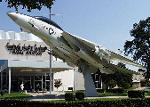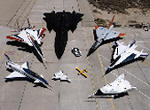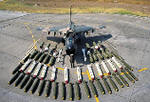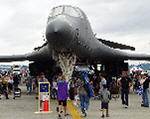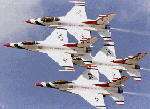
|
Description
| Manufacturer: | Boeing | |
| Base model: | 247 | |
| Designation: | 247 | |
| Version: | D | |
| Basic role: | Commercial Transport | |
| Crew: | 3 crew, 10 passengers | |
Specifications
| Length: | 51' 5" | 15.7 m | |
| Height: | 12' 5" | 3.8 m | |
| Wingspan: | 74' 1" | 22.6 m | |
| Wingarea: | 836.4 sq ft | 77.7 sq m | |
| Empty Weight: | 8,921 lb | 4,055 kg | |
| Gross Weight: | 16,770 lb | 7,621 kg | |
| Max Weight: | 16,805 lb | 7,623 kg | |
Propulsion
| No. of Engines: | 2 | ||
| Powerplant: | Pratt & Whitney S1H1-G Wasp | ||
| Horsepower (each): | 550 | ||
Performance
| Cruise Speed: | 188 mph | 304 km/h | 164 kt |
| Max Speed: | 199 mph | 322 km/h | 174 kt |
| Climb: | 1,148 ft/min | 350 m/min | |
| Ceiling: | 25,387 ft | 7,740 m | |
Examples of this type may be found at
| Museum | City | State |
| Canada Aviation Museum | +ttawa | Ontario |
| National Air and Space Museum | Washington | Dist of Col |
247D on display
National Air and Space Museum |
Recent comments by our visitors
| Coach Outlet Store Online delaware, AZ | Coach Outlet StoresChanel HandbagsLouis Vuitton HandbagsCoach Outlet StoreCoach Outlet OnlineCoach Online Outlet StoreLouis Vuitton SunglassesLouis VuittonCoach Purses OutletCoach Outlet StoresCoach PursesLouis VuittonLouis Vuitton Outlet StoresLouis VuittonLouis Vuitton OutletLouis Vuitton OutletLouis Vuitton OutletCoach Outlet Store OnlineLouis Vuitton PursesLouis VuittonCoach Outlet OnlineLouis Vuitton PursesCoach HandbagsLouis Vuitton OutletCoach Store OnlineCoach OutletCoach WalletsLouis Vuitton BagsCoach PursesLouis VuittonAuthentic Louis VuittonLouis VuittonCoach Outlet StoresLouis Vuitton Bagswww.louisvuitton.comLouis Vuitton BagsLouis VuittonCoach Outlet OnlineCoach Factory OnlineCoach Outlet OnlineLouis Vuitton SaleLouis Vuitton OutletLouis Vuitton OutletLouis Vuitton BagsLouis Vuitton SunglassesCoach BagsLouis Vuitton Outlet StoreLouis Vuitton OutletCoach Purses OutletCoach PurseLouis Vuitton BagsLouis Vuitton PursesCoach Purse OutletCoach Outlet OnlineLouis Vuitton HandbagsLouis Vuitton HandbagsCoach Purse OutletChanel BagsLouis Vuitton HandbagsLouis Vuitton BagsLouis VuittonLouis VuittonCoach OutletLouis Vuitton 2012Coach Outlet Store OnlineLouis Vuitton HandbagsLouis Vuitton PursesCoach Outlet StoreCoach Outlet Store OnlineCoach Outlet Store OnlineLouis Vuitton OutletLouis Vuitton USACoach Factory Outlet StoreLouis Vuitton OutletCoach PurseCoach Outlet OnlineCoach Store Online02/12/2012 @ 17:09 [ref: 52680] |
| Orvin Ongstad thousand oaks, CA | I grew up in a small town in North Dakota named Manfred.
As a child, standing in our back yard I saw this twin engine airplane -- the only one I ever saw -- flying towards the West over our town. What struck me as odd was the the plane's tail was set up so high compaired to the nose -- it was as the plane had it's nose pointed down while still flying at the same altitude. Later I saw a picture of the boeing 247D and recognized it as the plane I had seen. When I saw it was in the early 30's - what year I don't remember but I think it must have been in 1930-32 time period. I'll never forget the impression of this plane flying with it's nose down and it's tail high and I have always wondered how come it those to fly over our little town. 10/15/2008 @ 20:10 [ref: 22865] |
| Boeing Company Chicago, IL | The revolutionary Boeing Model 247, developed in 1933, was an all-metal, twin-engine airplane and the first modern passenger airliner. It had a gyro panel for instrument flying, an autopilot, pneumatically operated de-icing equipment, a variable-pitch propeller and retractable landing gear.
It took the Model 247 20 hours, with seven stops, to fly between New York and Los Angeles. However, because the 247 flew at 189 mph, its trip was seven and a half hours shorter than that made by any previous airliners. Seventy-five 247s were built. Boeing Air Transport flew 60 Model 247s. United Aircraft Corp. flew 10, and the rest went to Deutsche Lufthansa and a private owner in China. The 247s remained in airline service until World War II, when several were converted into C-73 transports and trainers. Some were still flying in the late 1960s. Along with the Douglas DC-2 that supplanted it, the Model 247 ushered in the age of speed, reliability, safety and comfort in air travel. Specifications First flight: Feb. 8, 1933 Model number: 247 Classification: Commercial transport Span: 74 feet Length: 51 feet 7 inches Gross weight: 13,650 pounds Top speed: 200 mph Cruising speed: 189 mph Range: 745 miles Ceiling: 25,400 feet Power: Two 500-horsepower P&W Wasp engines Accommodation: 3 crew, 10 passengers, 400 pounds of mail Copyright © 1995 - 2007 Boeing. All Rights Reserved 12/03/2007 @ 12:33 [ref: 18777] |
| David C. Stamps , TX | While stationed in Viet Nam (1971 -1972) at Tan Son Nuet AB, I saw on several occasions a Boeing 247(?). The major difference between the one I saw and the one you have pictured is on the one I saw, the windshield had a reverse cant (the top of the windshield projected out further than the bottom), other than this feature it appears the same as the one in your photos. Additionally as a life member of the CAF, I appreciate your efforts and enjoy your website. 01/11/2007 @ 20:46 [ref: 15163] |
| Bob Clarke Hanover, PA | The military designation was C-73 and one is said to be on display in the Canadian National Air Museum. 04/28/2000 @ 16:55 [ref: 135] |
Recent photos uploaded by our visitors
